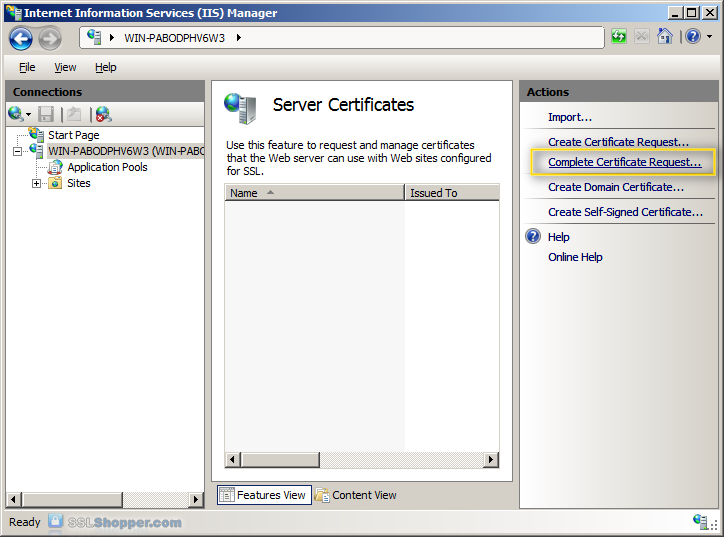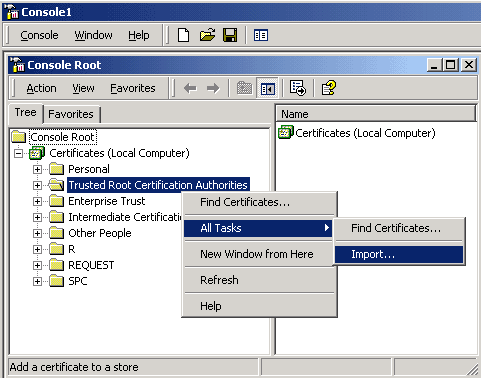- Free Server Ssl Certificate
- Windows Server 2003 Install Ssl Certificate Wordpress
- Install Godaddy Ssl Certificate Windows Server 2003
- Windows Server 2003 Install Ssl Certificate On Redhat 7
- Installing Ssl Certificates Windows Server
Where IP address of CA is the IP address or name of the Certificate server. On the initial Welcome page of the Certificate server, click Request a certificate, and then click Next. On the Choose Request Type page, click Advanced request, and then click Next. On the Advanced Certificate Requests page, click. Install root and intermediate SSL Certificates on Microsoft Windows Server. Click File in the top menu and select Add/Remove Snap-in. Select Certificates from the snap-in list and click Add. Select Computer account and click Next. Select Local computer and click Finish. Close the Add Standalone Snap-in dialog window and click OK in the Add/Remove Snap-in window. Process pending SSL cert request and install certificate on Windows 2003 (IIS6) Click Process Certificate Request: Click Browse and select the certificate file you received from the third party certificate authority ( GoDaddy etc) Click Ok and Next / Finish to process the pending certificate request. If you haven’t already done so, you will need to import the intermediate certificate from your certificate authority. 0 0 To generate a Certificate Signing Request (CSR) for Server 2003 – IIS 6 you will need to create a key pair for your server the public key and private key. These two items are a digital certificate key pair and cannot be separated. On Windows type systems PFX/PKCS12 requests are made, and are stored.
-->When creating a self-hosted Windows Communication Foundation (WCF) service with the WSHttpBinding class that uses transport security, you must also configure a port with an X.509 certificate. If you are not creating a self-hosted service, you can host your service on Internet Information Services (IIS). For more information, see HTTP Transport Security.
To configure a port, the tool you use depends on the operating system that is running on your machine.
If you are running Windows Server 2003 or Windows XP, use the HttpCfg.exe tool. With Windows Server 2003 this tool is installed. With Windows XP, you can download the tool at Windows XP Service Pack 2 Support Tools. For more information, see Httpcfg Overview. The Windows Support Tools documentation explains the syntax for the Httpcfg.exe tool.
If you are running Windows Vista, use the Netsh.exe tool that is already installed.

This topic describes how to accomplish several procedures:
Determining a computer's current port configuration.
Getting a certificate's thumbprint (necessary for the following two procedures).
Binding an SSL certificate to a port configuration.
Binding an SSL certificate to a port configuration and supporting client certificates.
Deleting an SSL certificate from a port number.
Note that modifying certificates stored on the computer requires administrative privileges.
To determine how ports are configured
In Windows Server 2003 or Windows XP, use the HttpCfg.exe tool to view the current port configuration, using the query and ssl switches, as shown in the following example.
In Windows Vista, use the Netsh.exe tool to view the current port configuration, as shown in the following example.
To get a certificate's thumbprint
Use the Certificates MMC snap-in to find an X.509 certificate that has an intended purpose of client authentication. For more information, see How to: View Certificates with the MMC Snap-in.
Access the certificate's thumbprint. For more information, see How to: Retrieve the Thumbprint of a Certificate.
Copy the thumbprint of the certificate into a text editor, such as Notepad.
Remove all spaces between the hexadecimal characters. One way to accomplish this is to use the text editor's find-and-replace feature and replace each space with a null character.
Free Server Ssl Certificate
To bind an SSL certificate to a port number
In Windows Server 2003 or Windows XP, use the HttpCfg.exe tool in 'set' mode on the Secure Sockets Layer (SSL) store to bind the certificate to a port number. The tool uses the thumbprint to identify the certificate, as shown in the following example.
The -i switch has the syntax of
IP:portand instructs the tool to set the certificate to port 8012 of the computer. Optionally, the four zeroes that precede the number can also be replaced by the actual IP address of the computer.The -h switch specifies the thumbprint of the certificate.
In Windows Vista, use the Netsh.exe tool, as shown in the following example.
The certhash parameter specifies the thumbprint of the certificate.
The ipport parameter specifies the IP address and port, and functions just like the -i switch of the Httpcfg.exe tool described.
The appid parameter is a GUID that can be used to identify the owning application.

To bind an SSL certificate to a port number and support client certificates
In Windows Server 2003 or Windows XP, to support clients that authenticate with X.509 certificates at the transport layer, follow the preceding procedure but pass an additional command-line parameter to HttpCfg.exe, as shown in the following example.
The -f switch has the syntax of
nwhere n is a number between 1 and 7. A value of 2, as shown in the preceding example, enables client certificates at the transport layer. A value of 3 enables client certificates and maps those certificates to a Windows account. See HttpCfg.exe Help for the behavior of other values.In Windows Vista, to support clients that authenticate with X.509 certificates at the transport layer, follow the preceding procedure, but with an additional parameter, as shown in the following example.

To delete an SSL certificate from a port number
Windows Server 2003 Install Ssl Certificate Wordpress
Use the HttpCfg.exe or Netsh.exe tool to see the ports and thumbprints of all bindings on the computer. To print the information to disk, use the redirection character '>', as shown in the following example.
In Windows Server 2003 or Windows XP, use the HttpCfg.exe tool with the delete and ssl keywords. Use the -i switch to specify the
IP:portnumber, and the -h switch to specify the thumbprint.In Windows Vista, use the Netsh.exe tool, as shown in the following example.
Install Godaddy Ssl Certificate Windows Server 2003
Example
Windows Server 2003 Install Ssl Certificate On Redhat 7
The following code shows how to create a self-hosted service using the WSHttpBinding class set to transport security. When creating an application, specify the port number in the address.